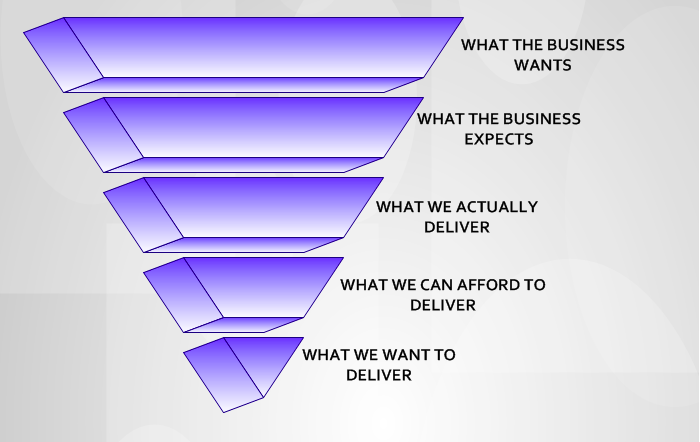So our job is to keep the lights on and I have talked about doing the odd minor change to keep the bill payers happy. But what do we do when funding is tight and we have to constrict our funding to do the bare minimum and “REALLY just keep the lights on”? How do we still maintain the illusion of being responsive to the business needs as they will no doubt be under pressure to change the way they do things, and as a result the systems that enable those things will need changing also.
So here is the source of the problem.
What the business wants
The business wants everything they ask for and they want it for nothing. They want every submission or request for change they put in will be actioned accordingly and presented to them with a bow on top. And why shouldn’t they? After all, the IT department doesn’t make the organisation any money and doesn’t form part of its core business and yet it spends millions of dollars each year, so they should be responsive to the business needs.
What the business expects
Then reality sets in. They want everything but they actually expect a little less than that. This varies from organisation to organisation. Some expect the top level and are somewhat delusional. Some expect the bottom level as they have zero faith in the IT department to deliver anything at all and expect all requests to go into a black hole, never to be seen again.
Both of these are at the tips of the bell curve though and your average organisation expects you to be responsive to their needs but realises you have limited resources (like them in most cases) and have to perform some level of prioritisation. Sure, they will whine about it but at the bottom of their hearts they know its a fact of life as often their requests directly conflict with another part of the business who may want something completely different.
What we actually deliver
However, what we actually delivery is somewhat less than they expect us to and is often the source or interdepartmental angst. They expect a level of prioritisation, but our opinions of where that line in the sand sits, differ. The business will prioritise in accordance to importance to them as they see it. We however, include several other pieces of work into that mix that are required to keep the lights on, that they have no visibility of, and as a result when they expect their top 5 out of 10 to be delivered, we may only deliver on their top 3.
What we can afford to deliver
Realistically we deliver more than we can afford and make cuts elsewhere to deliver more for the business in the fight for relevance, especially during hard times when the business is looking for budgets to cut. It’s these “cuts elsewhere” that causes us some angst later on as they may be maintenance tasks, software testing, process definition, etc. We weigh up the pro’s and con’s of doing enhancements and keeping the business happy against the risk inherent in not doing basic maintenance tasks or reducing the testing regime.
What we want to deliver
It really is my job just to keep the lights on for now and ever more. OS, platform and technology upgrades are “business as usual” as they make the system future proof and ensure it will work now and into the not to distant future. System enhancements are not my business. If its quick and I can squeeze it into a maintenance release then I don’t mind doing it. If its new functionality or anything that requires more than a quick regression test, then it really is out of my scope and should be the domain of the planning or projects area.
As a support manager, my role is to juggle and negotiate my way through this minefield of priorities and escalations and deliver something to the business that will perhaps not keep them happy but keep them content. There is no golden rule or secret formula that determines which enhancements you do and unfortunately it comes down to each particular organisation or even down to particular individuals or personalities at varying levels throughout that organisation. Often a business analyst can look deep into these requests if time permits and really determine the business value and then determine the priority based on some predetermined matrix which of course includes budget constraints along with a few other criteria.
So my advice in this problem is to determine how you should prioritise your enhancements, then make up a selection criteria on your own terms, cross reference them to the rest of the organisations expectations and then evaluate this against the costs involved. Its no use doing one big change that uses your entire budget surplus when you could do multiple smaller enhancements that will keep multiple units off your back for a period.
Good luck. You will need it.

